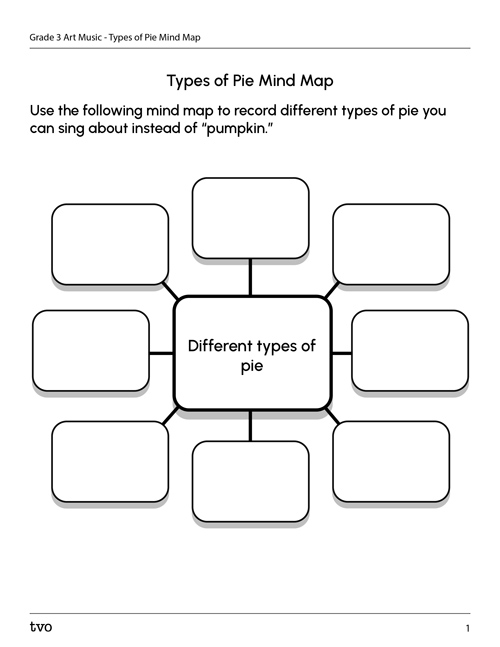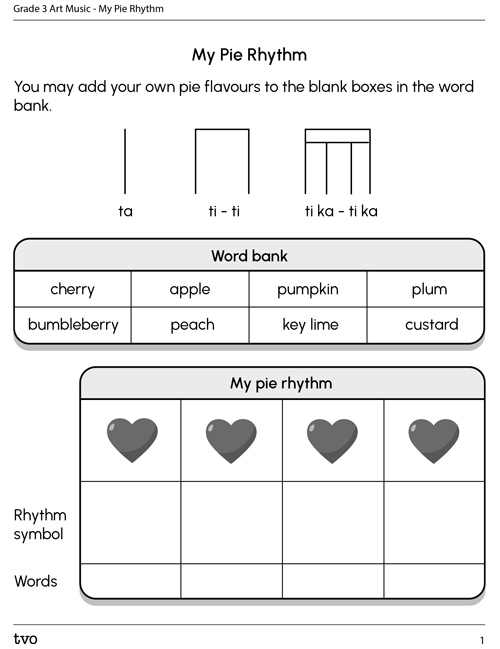Minds On
Today’s vocabulary
Press the following tabs to access today’s vocabulary.
A steady and repeating pulse in music. Part of the element of duration.
A pattern of long and short sounds or silences. Rhythm is different from beat; for example, the rhythm at the beginning of a song might be “ta, ta, ti-ti, ta”. The beat is the steady pulse of “ta, ta, ta, ta”. Explore also beat.

A note that is held for one beat.

A note that is held for one-half of a beat. Beams can connect eighth notes.

A note that is held for two beats.

A note that is held for one-quarter of a beat.
A rhythmic or melodic pattern that repeats. An example of a simple rhythmic ostinato might be “ta, ta, ti-ti, ta”. A melodic ostinato might be “so–so–mi–mi–so–so–mi”. Explore alsooral prompts; rhythmic pattern; solfège.
Let’s get started
In this learning activity, we will learn a song about a curious house that is filled with pumpkin pie!
Explore the song “Great Big House in New Orleans” and an excerpt of the lyrics.
Access the following audio clip with an excerpt of the song “Great Big House in New Orleans” performed by Pete Seeger and friends.
Great Big House
Explore the song again!
This time speak or sing the words to “Great Big House in New Orleans” while you keep the beat.
If possible, point to the hearts while you speak or sing the song.

This house is filled with pumpkin pie!
What other pie flavours are there? Do you have a favourite type of pie?
Brainstorm a list of pie flavours we could sing about.
Record your answers orally, digitally or in print, or using the following mind map.
Complete the Types of Pie Mind Map in your notebook or use the following fillable and printable document to record your ideas of different types of pie.
Press the ‘Sample answer’ button to check out possible answers for different types of pie to sing about.
Cherry, apple, blackberry, cheese, lemon, spinach, peach, etc.
Action
Get ready, get set…
Our pie rhythm
Pumpkin, cherry, apple, cheese!
There are so many different flavours of pie!
Let’s explore the syllables in different flavours of pie.
Determine which group you would add each word to. Use the arrow buttons to navigate between cards.

Two teachers having a conversation. The first teacher says: “We can use our pie flavours to create a rhythm pattern! Teacher B, choose 2-3 pie flavours.” The second teacher responds: “How exciting, Teacher A! Ok, how about “peach,” “apple,” and “bumbleberry”? The first teacher replies: “Great! Peach, apple, bumbleberry pie!” Now you try!”. The second teacher responds: Peach, apple, bumbleberry pie! Peach, apple, bumbleberry pie!

A table with the title Our Pie Ostinato. There are eight squares, four squares per row. In the first row, each square has a big red heart. In the second row, at the bottom of the first square, it says peach. At the bottom of the second square, it says apple. At the bottom of the third square, it says bumbleberry. At the bottom of the fourth square, it says pie.
Which word makes one sound on a beat?
Press ‘Answer’ to learn which word makes one sound on a beat.
Peach
Which word makes two sounds on a beat?
Press ‘Answer’ to learn which word makes two sound on a beat.
Apple
Which word makes four sounds on a beat?
Press ‘Answer’ to learn which word makes four sound on a beat.
Bumbleberry
Our pie flavours have rhythm just like music does!
In the next section, we will explore the names of different rhythms. In music, we call these rhythm syllables.
Rhythm syllables
One sound on a beat is called ta.

Two sounds on a beat is called ti-ti.

One sound that stretches over two beats is called ta-ah.

We can also have four sounds on a beat!
This is called tika-tika.

Sixteenth notes are smaller than eighth notes!
A group of four sixteenth notes is equal to two eighth notes.

=

A group of four sixteenth notes is equal to one quarter note.

=

You’d need two groups of sixteenth notes to equal one half note!

=

Check your understanding
Return to the beat chart from the Minds On section and answer the questions that follow.

Consider the following questions.
Press the ‘Answer’ button for each question to find out the answers.
1. How many heartbeats are in each line?
There are four heartbeats in each line.
2. How many heartbeats are there altogether?
There are 16 heartbeats altogether.
3. In Line 1, are there any heartbeats with two sounds?
Yes there are! In Line 1, heartbeats 1, 2, and 3 have two sounds.
4. Are there any words in the song that take up two heartbeats?
Yes there are! The words “high” and “pie” take up two heartbeats.
5. Are there any heartbeats with four sounds?
No, there aren’t any heartbeats with four sounds.
Adding tika-tika, ti-ti, and ta
Next, let’s return to our pie rhythm and add rhythm symbols (tika-tika, ti-ti, and ta).
If possible, clap, tap, or speak the rhythm!
Don’t forget to do your safety checks and check your surroundings.
Add the correct rhythm symbols to the word pattern to create a rhythm.
Then, respond to the questions that follow.
Respond to the following questions. Be sure to explain your thinking!
- Which rhythm symbol did you add to the word peach?
- Which rhythm symbol did you select for the word apple?
- Which rhythm symbol did you select for the word bumbleberry?
Record your responses digitally, orally, or on paper.

Consolidation
Putting it all together
Create your own pie rhythm!
Follow these steps to create your own pie rhythm!
Record your pie rhythm digitally, orally, or on paper.
Complete the My Pie Rhythm in your notebook or use the following fillable and printable document. If you would like, you can use speech-to-text or audio recording tools to record your thoughts.
Reflection
How do you feel about what you have learned in this activity? Which of the next four sentences best matches how you are feeling about your learning? Press the button that is beside this sentence.
I feel…
Now, record your ideas about your feelings using a voice recorder, speech-to-text, or writing tool.

